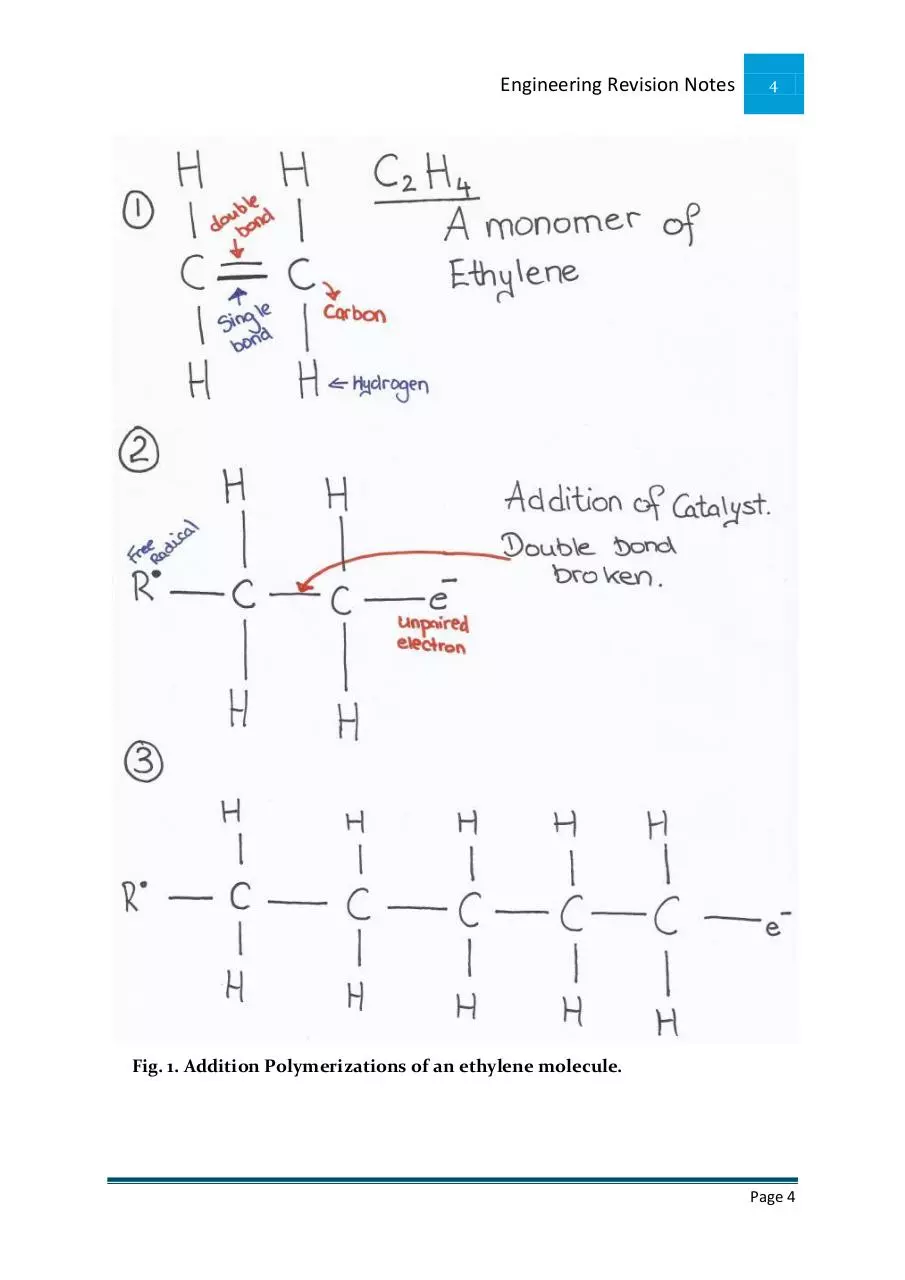engineering notes (PDF)
File information
Title: Engineering Revision Notes
Author: Laura Fitzgerald
This PDF 1.5 document has been generated by Microsoft® Office Word 2007, and has been sent on pdf-archive.com on 22/08/2016 at 13:21, from IP address 95.44.x.x.
The current document download page has been viewed 903 times.
File size: 1.19 MB (32 pages).
Privacy: public file





File preview
Leaving
Cert
Engineering Revision Notes
Laura Fitzgerald
Leaving Cert
Engineering Revision Notes
2
INDEX
1) Polymers ..................................................................................................................................... 3
Condensation & Addition Polymerization………………………………………………………………………….....3
General definitions………………………………………………………………………………………………………………...5
Thermoplastics vs. Thermosetting plastics……………………………………………………………………………6
2) Joining ........................................................................................................................................ 9
Mig & Tig Welding ...................................................................................................................... 9
Manual Metal Arc welding ......................................................................................................... 11
Oxy Acetylene welding…………………………………………………………………………………………………..…….13
Submerged Arc & Resistance seam welding…………………………………………………………………..…….14
3) Material Testing………………………………………………………………………………………………………………….15
Material Properties……………………………………………………………………………………………………………….15
General Definitions & Properties……………………………………………………………………………………......16
Non-Destructive Testing…………………………………………………………………………………………….………..17
Destructive Testing……………………………………………………………………………………………………………...19
4 Internal Structures of Materials.............................................................................................20
Bonding.........................................................................................................................................20
Structure........................................................................................................................................21
Defects...........................................................................................................................................23
5) Cooling Curves............................................................................................................................25
6) Iron Carbon Equilibrium Diagrams.......................................................................................27
7) Heat Treatment..........................................................................................................................29
8) General.........................................................................................................................................31
9) References...................................................................................................................................32
Page 2
Engineering Revision Notes
3
1. POLYMERS
Monomer
A monomer is a molecule of a compound which reacts with other monomers to form a
polymer.
Mer
A mer is a repetitive unit in a polymer.
Addition Polymerisation of Ethylene (Thermoplastics)
Ethylene consists of 4 hydrogen atoms and 2 carbon atoms joined together by a
double bond. (Primary and secondary bond)
A catalyst is added which introduces a free radical. A free radical is a reactive
atom containing an unpaired electron.
The free radical joins onto one of the monomers causing the weak secondary
bond between the carbon atoms to break.
The mer cannot exist on its own as it now has an unpaired electron.
It very rapidly links with other mers to form long chain like structures called
polymers.
To stop this reaction an inhibitor is added. This results in a large number of
interwoven chains.
Where these chains touch/overlap, secondary bonds called Van Der Waals
forces are formed. These are weak bonds that will allow the polymer to soften
whereby its shape can be altered by applying heat or pressure.
Condensation Polymerisation (thermosetting plastics)
The polymer molecules react chemically to form new molecules with
water/alcohol eliminated as a bi-product.
It forms strong primary bonds with cross links between chains
The polymer produced, once moulded, cannot be re-softened/re-moulded as a
result
E.g. Phenol Formaldehyde
Page 3
Engineering Revision Notes
4
Fig. 1. Addition Polymerizations of an ethylene molecule.
Page 4
Engineering Revision Notes
5
C0-Polymer
Two unlike monomers joined together in a polymer chain. E.g. Poly Vinyl Acetate
Elastomer
A group of polymers consisting of linear chains that are coiled, entangled and are
subject to cross linking. This allows these materials to be very elastic at room
temperature.
Lubricants
Make the polymer easier to mould. Various types of waxes are used in small amounts.
Pigments
Give the Polymer colour
Stabilisers
Stabilisers are substances which stop a polymer ageing. They improve resistance to
heat and light.
Vulcanisation
Natural rubber is processed with sulphur
to form cross links between chain
molecules to improve wear resistance
and life. It is less flexible that natural
rubber which is soft.
Van Der Waals Forces
Weak secondary bonds. May be
disrupted by heat.
Fig. 2. Van Der Waals Forces vs. Cross Links
Page 5
Engineering Revision Notes
6
Differences between Thermoplastics and thermosetting plastics
Bonding
Process
Properties
Thermoplastics
Bonded by covalent bonds
Secondary bonds with
weak Van Der Waals forces
which can be broken down
by heat
Addition Polymerisation
Monomers join up to form
long chain like molecules
called polymers.
These are arranged like
spaghetti and when each
polymer overlaps, weak
temporary bonds called
Van Der Waals forces are
formed.
E.g. Polyethylene
Low melting points.
Easy to mould
Can be remoulded and are
subject to disruption by
heat.
Can be recycled .
Low tensile strength.
Secondary bonds between
molecule chains.
Thermosetting Plastics
Bonding by Covalent
bonds.
Primary bonds held
together by strong cross
links.
Condensation Polymerisation
Forms strong primary
bonds between chains.
Two monomers react to
form a new molecule with
water or alcohol emitted
as a bi-product.
The polymer cannot be resoftened.
E.g. Phenol Formaldehyde
High melting points.
High tensile strength.
Can withstand high
temperatures without
losing their rigidity.
Primary bonds between
molecule chains.
Page 6
Engineering Revision Notes
7
Thermosetting plastics
Compression Moulding
Split formed mould.
Polymer can be in powder or slug form.
Combination of heat and pressure (coalescence) allows piece to be formed.
Triggers chemical reaction cross linking and the object is removed.
High quality finish
E.g. Electrical fittings, Bottle tops.
Transfer Moulding
The moulding powder is placed in a compartment above the mould where it is
heated.
The plunger forces the molten polymer into a cooled cavity.
The polymer solidifies in the mould which is then opened and the product is
removed.
Used to make complex products.
E.g. socket covers.
Thermoplastics
Extrusion
The thermoplastic moulding powder is fed from a hopper into a heated
chamber.
A large archimedian screw moves the softening plastic through the chamber.
This plastic is forced through a die at the end of the machine. The die gives te
desired extruded shape which is then cooled by air or water and cut into
lengths.
It may also be cooled in a vacuum chamber.
E.g. Piping.
Injection Moulding
The thermoplastic in granule form is fed into a heated compartment by a
hopper.
A plunger forces the plastic along the machine barrel where they are melted by
heaters.
A torpedo compacts the materials.
The softened materials are then forced into the mould by the torpedo where it
cools and solidifies.
Page 7
Engineering Revision Notes
8
The mould is opened and the plastic product is ejected.
E.g. Lego
Calendering
Continuous lengths of sheets are produced by calendaring.
The material passes through a series of heated rollers to produce the desired
thickness of the material.
It is the cut to size or collected on a roll.
E.G. Cling film.
Fig. 3. Compression moulding (above) & Transfer
moulding (below).
Page 8
Engineering Revision Notes
9
2. JOINING
MIG welding
Semi automatic process.
A consumable bare wire electrode fed continuously into the weld pool through
torch by spool.
An inert gas, e.g. argon, has a fluxing action and creates a protective shield
around the weld pool.
The feed and flow rate are set by the operator.
Does not produce slag.
Used on sheet metals.
TIG welding
Utilises a non-consumable tungsten electrode
An electric arc is formed between a non-consumable electrode and the
metal being welded.
An inert gas such as argon creates a protective gas shield.
A filler metal is added manually.
No slag is produced.
MIG vs. TIG welding
MIG
Semi-automatic
Argon gas
Electrode is consumable.
Spool
TIG
Manual
Tungsten electrode: nonconsumable
Filler metal added manually
Used on aluminium
Page 9
Download engineering notes
engineering notes.pdf (PDF, 1.19 MB)
Download PDF
Share this file on social networks
Link to this page
Permanent link
Use the permanent link to the download page to share your document on Facebook, Twitter, LinkedIn, or directly with a contact by e-Mail, Messenger, Whatsapp, Line..
Short link
Use the short link to share your document on Twitter or by text message (SMS)
HTML Code
Copy the following HTML code to share your document on a Website or Blog
QR Code to this page

This file has been shared publicly by a user of PDF Archive.
Document ID: 0000415174.